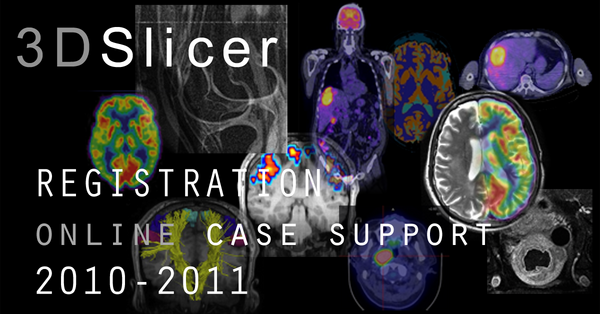Projects:RegistrationDocumentation:UseCaseAdvertisement
From NAMIC Wiki
Home < Projects:RegistrationDocumentation:UseCaseAdvertisement
back to Use Case Library
back to Registration Main Page
Contents
Registration in 3D Slicer- Call for Datasets for the Registration Case Library
Let us help you turn your registration problem into a success story. If you have an interesting or vexing registration problem that is not yet covered in the Library , send us your one case: we will try to register it for you and design a tailored registration approach you can use. We then add the anonymized data to the library and build a guided step-by-step tutorial for it. This is a time and resource limited service available until July 1, 2011. If interested drop a line to meier at bwh.harvard.edu. We'll take it from there.
What You Will Need To Do
- just send us an Email with a brief description of the problem, send to meier at bwh.harvard.edu. We'll take it from there.
- All you will have to do is save your image data as NRRD or NIFTI files and provide a brief description of the registration problem.
- if you are unsucessful in saving the data as described above (which is the anonymization), see our Anonymization Instructions , or let us know and we'll walk you through it.
What We Will Do
- we will seek the best possible registration obtainable with the most recent version of 3DSlicer, and send you the final result as well as the procedure and parameters.
- we will post the anonymized image data as a new case in our Slicer Registration Case Library.
- an acknowledgment of your lab as the data source is posted, if desired with a link to your institution and/or related research papers
- the exact workflow of obtaining the registration will be posted alongside the data as a guided step-by-step tutorial
- the parameters for successful registration will also be posted as a loadable custom "Registration Preset" file that you can load directly into slicer and apply on your data
- if you can provide us with fiducial pairs or other criteria that define a good registration, we will use them in optimization efforts. You can use the 3DSlicer Fiducials module to select one or more pairs of points that should line up. Detailed instructions below.
- example of what the final shared product will look like
Limitations/Disclaimer
- we can assist only with 3DSlicer registration software.
- if you have a study of N cases, pick a typical one or a hard one. We can register only 1 or 2 cases of the same type. But if you have outliers that do not perform as the rest these are welcome.
- this is a time-limited service, available in a first trial until 'July 1, 2011.
- depending on workload, we try to get you something within a few weeks, but we cannot guarantee a particular result or a specific turnaround time.
- all shared data-sets are anonymized:
- Sharing anonymized data in most cases is IRB exempt based on Code of Federal Regulations 45 CFR 46.101(b), which lists as exemption category 4:
Unless otherwise required by department or agency heads, [...] the following categories are exempt [...]:
4.Research involving the collection or study of existing data, documents, records , pathological specimens, or diagnostic specimens, if these sources are publicly available or if the information is recorded by the investigator in such a manner that subjects cannot be identified, directly or through identifiers linked to the subjects.
- anonymization is easy: load your data into slicer. Save it as NRRD file (in the Save dialog box, make sure 'nrrd' is selected as filetype for all output images). This will save only the raw image data + voxelsize and image orientation. No other data re. subject, scanner or institution are present in the NRRD file. For details see our Anonymization Instructions
- if you are unsucessful in anonymizing the data as described above, let us know and we'll walk you through it.
- for some high-resolution structural head MRI we may have apply additional "defacing" (i.e. masking of image parts of the face and/or ears) before posting. This removal applies only to image content of facial features that might be recognizable as a 3D rendering. We will do this for you. Only the defaced data is kept.
